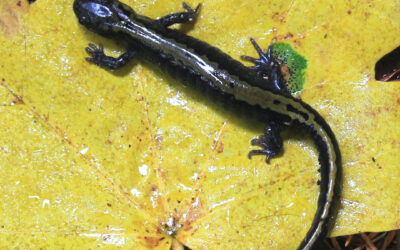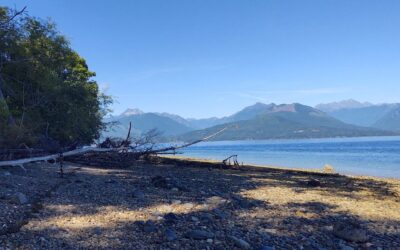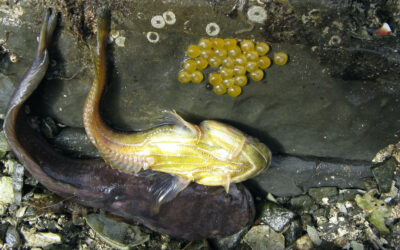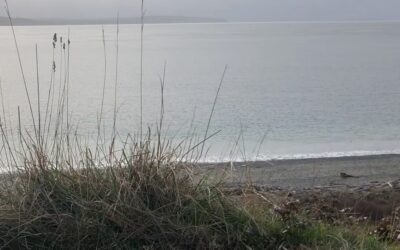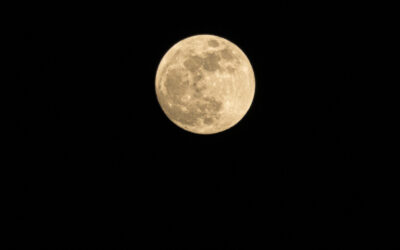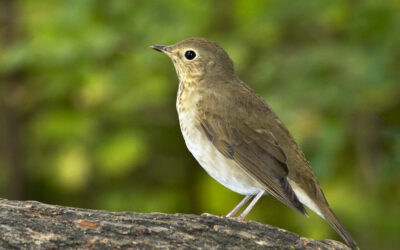How to listen to the Salish Sea
by Gordon Hempton, Autumn 2023
photos and audio by Gordon Hempton except as noted

How to Listen to the Salish Sea
by Gordon Hempton
photos and audio by Gordon Hempton except as noted
Autumn 2023
Clap your hands, drop a pencil, set down a coffee mug — each event makes a sound — a different sound. Our auditory world never stops reporting the news, even while we sleep — that’s why alarm clocks work.
To be the first to hear the breaking news has been a driving force during animal evolution.
The forests 200 million years ago were different than today as flowering trees and plants had not yet arrived, but the forests were still a complex, intertwined, maze of branches. The night ambience of these ancient forests were dominated by insects who used the energy-cheap high frequencies which left the more energy-expensive lower frequencies available for the frogs who ate the insects. Imagine the insect medleys and frog choruses which echoed through these ancient arboreal concert halls! The sound space provided a soundtrack for some early mammals to follow along the branches and intersections of branches to find food and return to the nest to nurse their young.
The early mammalian success with hearing and smell caused them to flourish and evolve into new species. Each new species would tune its hearing to survival-relevant sounds and tune out vibrations that were simply noise (meaningless sounds). Each new species would hear differently than all others according to its unique information needs. The most important information related to detecting the approach of a predator. Also of paramount importance was information that indicated food sources. Only when alive and thriving would the risky business of voice production or message sending come into play. Voice allowed more complex and efficient animal behavior, such as establishing territorial boundaries, advertising for a mate, and maintaining social cohesion in species that lived in groups. The world grew to be alive with voices!
Then along came the industrial revolution and an unseen toxin — noise pollution. (Noise pollution is any vibration that denies animals, including us, access to meaningful information.) Hearing, for the first time, became less useful, and seeing grew in importance.
One of the first products of the industrial revolution was print media which, along with mandatory literacy, illuminated the world of imaginations. But before we became readers we were listeners. Early industrial revolution writers — Mark Twain for example — were still describing deep meaningful soundscapes for a listening audience.
Not a sound anywheres — perfectly still — just like the whole world was asleep, only sometimes the bullfrogs a-cluttering, maybe…sometimes you could hear a sweep screaking; or jumbled up voices, it was so still, and sounds come so far… then the nice breeze springs up, and comes fanning you from over there, so cool and fresh and sweet to smell on account of the woods and the flowers; but sometimes not that way, because they’ve left dead fish laying around, gars and such, and they do get pretty rank; and next you’ve got the full day, and everything smiling in the sun, and the song-birds just going it!
From Adventures of Huckleberry Finn, Ch.19, Dawn on Miss. River
But sadly, even Mark Twain’s passionate confessions to his attentive listening skills noted in his autobiography have fallen onto deaf eyes and many readers simple don’t notice.
If I were to ask you to listen to the Salish Sea (and I’m about to) do you think you could?
The first rule of listening is to let go of outcome. Don’t change the place; let the place change you! Are you ready to become someone different? Because when you listen closely, you can feel yourself actively change. It’s emotional.
Autumn is a great time to listen. Warm temperatures, higher humidity above the water’s surface than on land, and zero elevation provide for a more elastic medium. Sound waves love elastic media — whether air, water, rock, glass…sound passes differently through different media depending on its elasticity. Elastic air allows sound waves to travel further and more clearly than rarified atmospheres, say if you were at the wind-swept top of a mountain.
Healthy human ears positioned at the water’s edge on a windless morning in autumn may hear sounds from more than 20 miles away! The area of a circle with a radius of 20 miles is an area of awareness equal to 1,256 square miles (A=πr2). This is the area of your auditory awareness.
Let us practice a listening exercise now, at the computer. Then we will do a similar exercise at the edge of the Salish Sea. You may want to print out the last part of this article before you go.
Simply relax. The ear contains some of the smallest bones and muscles in the body. The more calmly you listen the more you will hear. Sit or stand. Eyes open, obviously. Breathe deeply. Notice how good it feels to breathe in…and to breathe out. Good. Keep breathing slowly and deeply.
Step 1. What is the furthest sound you can hear? Give yourself time. Notice that some of the sounds will come through walls and even around corners. Resist the temptation to label sounds — just hear what you hear. Notice that the sounds come from all directions. Some sounds are more clear than others. This is your area of awareness for now.
One of the largest auditory horizons known to science belongs to the homing pigeon who can detect infrasound (frequencies below our hearing abilities) created by ocean waves hundreds of miles away.
Step 2. What is the faintest sound you can hear? Relax your lower jaw and allow your oral cavity to open slightly as this will allow your hearing to perform better. Our outer ears have curves, like musical instruments, to collect sound waves. Since we all have slightly different outer ears, we all hear differently. Do not try to hear what someone else hears — because you cannot. Just hear what you hear. The faintest sound defines your fidelity at this place and time.
According to American Naturalist John Muir, one of the faintest sounds audible to the human ear is the sound made by a Giant Sequoia seed when it falls onto thinly crusted snow.
Step 3. Now, do not listen for a sound, just listen to the place, all sounds at once. Give yourself time. If you catch yourself thinking, just acknowledge with a smile, then bring your conscious attention from your head to your chest.
Step 4. Note how you feel. Each place has a feeling, or summary conclusion of sensory information. It is likely that your heart rate has slowed and your sense of well-being has increased just by taking the time to become aware of where you are.
You can do this exercise anywhere, anytime, indoors, or out. And as you do, notice how each place produces a different feeling. Some places will naturally appeal to you more than others. If you want, you can use this method to navigate towards new places to discover.
The first humans appeared on the planet 2.5–3 million years ago as nomadic hunters and gatherers on the African savanna. They were dependent on their senses to solve problems that would mean the difference between perish and prosperity. For example, when resources ran low and it became necessary to move, once again, to a new location, which way should they go? Information, if it could be gathered from far away, would be valuable. The human ear is most sensitive to sounds that fall into the frequency bandwidth between 2.5–3.5 kHz, which is the resonant frequency of the auditory canal. The begging question: What sounds were so important for our distant ancestors to hear?
Evolving about the same time on the African savannas were the passerines or songbirds. They had a problem, too. Wind. Wind will take most sounds and quickly render them unintelligible. If a sound could be designed by evolution to hold up under windy conditions and still be recognizable at a distance, this would aid songbirds in attracting a mate. The answer was a song structure with amplitude modulation (quiet and loud song elements) and frequency modulation (low- and high-pitched notes) in rapid succession. Life could go on. And when we take a sound recording of the dawn chorus of songbirds and run it through a spectrum analyzer, we find that the primary content falls neatly between 2.5–3.5 kHz. If the birds are singing there is food, water, and a favorable season that will last long enough to raise their young. There is everything humans need to survive.
Coincidence that we hear birdsong as music?
Hold that thought. Next up: a field trip to the Salish Sea.
how to listen to the Salish Sea
Your assignment: Go to the edge of the Salish Sea. High energy shorelines are exposed areas that are generally louder; while low energy shorelines are protected areas that are generally quieter. Each place will sound different. For the purposes of this first exercise the nearest location will serve well and then you can expand to other areas as you develop your auditory acuity.
You may want to print out the information below to take with you.
Time required: 20 minutes, exclusive of travel time.
What to bring: Weather appropriate gear and a snack to keep your stomach from growling.
Who: Just you or, if with others, your companions clearly understand that everyone will be silent.
introduction
Before you go, check weather conditions, and if possible, select a morning when sea conditions are relatively calm. Dress appropriately. Rain may be hard to avoid during the late autumn and winter months so bring an umbrella instead of wearing a noisy rain jacket or pants. The umbrella can be held high overhead to reduce the sound of rain impacts and, with a little fun, you can also swing it behind you and use its parabolic shape to focus sounds at your ears to hear faint sounds better.
Once you have arrived at the shoreline, it is time to relax fully. Remember, your ears use some of the smallest muscles and bones in your body. The more you can relax the better able you will be able to hear. Position yourself comfortably about 10 feet from the water line facing the sea.
We will begin with sight. See the waves? Simply hold a relaxed gaze. Hunters call this scatter-vision. If you want to see something that is hiding, do not look for it but gaze in that direction and let the brain lock onto it.
Notice that the waves occur in sets, all traveling in the same direction, and likely there are other sets of waves traveling in at least a slightly different direction. Each set of waves was created by a separate event. Perhaps it was a dramatic weather event far away or simply a local breeze skimming the surface of the water.
Let your eyes find multiple wave patterns, no matter how small or faint. You are listening with your eyes. Do not focus your attention while you look for the waves, simply let your brain do its thing. The more relaxed you are, the more quickly the many subtle wave patterns will emerge.
These water waves serve as models for understanding sound waves.
The largest waves you see have the most energy. Large sound waves also produce loud sound. The smallest wave holds the least energy and the smallest sound waves are the faintest.
Some waves are spaced widely apart with long periods (measured in seconds) and are comparable to low frequencies (measured in cycles per second). Long wave periods and low frequency sounds travel the greatest distances — created by big events. Large species of animals, such as some whales and elephants, can produce and hear infrasound (frequencies too low for the human ear to hear) to communicate over great distances. Some smaller species, like pigeons, can hear infrasound originating many hundreds of miles distant, like ocean waves.
Some wave sets are tightly packed together. These waves have short periods and are comparable to high pitched sounds. These travel short distances and if present were created by local events. Look closer and you might even see a school of fish passing below the surface. Some species of animals, such as bats and dolphins, use high frequencies (ultrasound) to image at night or underwater.
As you continue to gaze calmly at the Salish Sea, note what happens when waves traveling in one direction pass through waves traveling in another direction.
What you see in these waves is a model of what you hear. Most auditory environments amount to a stormy sea of vibrations — rarely do we find the mirrored surface called silence. But there is one big difference between the waves we see and the waves we hear — while we are watching waves on the two dimensional surface of the water, sound waves are spherical and the auditory space is a foaming mass of expanding bubbles. At the center of each sound bubble we find the spot where the sound producing event occurred. The auditory world is so complex that it is hard to imagine, impossible, but we can hear it, easily and effortlessly — if we just let go. Don’t think, just listen and feel.
As before, take a deep breath. Notice how good it feels to both breathe in and breathe out.
Step 1. What is the furthest sound you can hear? Take time to let your auditory horizon expand while gazing calmly.
Step 2. What is the faintest sound you can hear? Let your lower jaw relax and open your oral cavity slightly.
Step 3. Now listen to this place — all sounds at once.
Step 4. Notice how you feel.
Here are some sounds of the Salish Sea that you can listen to without going to the beach.
Sounds of the Salish Sea

Acoustic ecologist Gordon Hempton has circled the globe three times in pursuit of the Earth’s rarest sounds. His sound portraits which record quickly vanishing natural soundscapes have been featured in People magazine and a national PBS television documentary, Vanishing Dawn Chorus, which earned him an Emmy. Hempton provides professional audio services to media producers, including Microsoft, Smithsonian, National Geographic and Discovery Channel. Recipient of awards from the National Endowment for the Arts and the Rolex Awards for Enterprise he is co-author of One Square Inch of Silence: One Man’s Quest to Preserve Quiet (Free Press/Simon & Schuster, 2010) and Founding Partner of Quiet Parks International. Gordon Hempton speaks widely about the importance of listening.
Table of Contents, Issue #21, Autumn 2023
Silent By Nature
by Tom Doty, Autumn 2023 Long-toed salamander. photo by Tom Dotyby Tom Doty Autumn 2023Harbingers of spring, amphibians in Kitsap County include both frogs and salamanders. The iconic body form and vocalizations of frogs are familiar, but less well known are their...
Sound Mapping Nature
by Micaela Petrini, Autumn 2023 Misery Point, Kitsap Peninsula. photo by Micaela Petriniby Micaela Petrini Autumn 2023Do you ever spend time outside with the intent of listening? Closing your eyes, opening your ears, and taking in all of the sounds around you? This...
Singing Bullhead
by Andy Lamb, Autumn 2023 A small, recently deposited clutch of eggs with a pair of plainfin midshipman fish. One is overturned, showing its distinctive underside. photo by Linda Schroederby Andy Lamb Autumn 2023Perhaps the most colourful family...
Atmosphere
Poem and video by Renee Gastineau Autumn, 2023Atmosphere Wind and watertogether and apartcrash and crackle to sooth restless thoughts.Today and tomorrowtogether and apartconnect with the wind and waves to saymove along, take a ride, enjoy the journey, embrace the flow...
Poetry-21
Photos by John F. Williams Autumn 2023 Photos by John F. Williams Autumn, 2023Blue Skies by Nancy Taylor birds have muchto say todayeach on a different noteyet in harmony pausingwhen wind whips upto listen, to defend,or tend hatchlings no alarmingdeesfrom...
Counting Thrush Songs
by John Neville, Autumn 2023 Swainson's Thrush. photo by Janine SchuttI Decided to Find Out by John Neville Autumn 2023COVID-19 kept me at home in the 2020 springtime so I was able to enjoy the birds in my own backyard on Salt Spring Island, BC. On May 9 I first heard...
PLEASE HELP SUPPORT
SALISH MAGAZINE
DONATE
Salish Magazine contains no advertising and is free. Your donation is one big way you can help us inspire people with stories about things that they can see outdoors in our Salish Sea region.
We also don't advertise Salish Magazine, so please spread the word of this online resource to your friends and colleagues.
Thanks so much for your interest and your support.
We also don't advertise Salish Magazine, so please spread the word of this online resource to your friends and colleagues.
Thanks so much for your interest and your support.








